The Mediators of the Relationship between Digitalisation and Construction Productivity: A Systematic Literature Review
Abstract
1. Introduction
- Explore the characteristics of previous digitalisation research in the construction context.
- Identify the themes in which digitalisation is excelling at positively influencing productivity.
- Formulate a conceptualization of the identified mediators for empirical investigation.
2. Materials and Methods
2.1. Stage 1: Identifying the Data Source
2.2. Stage 2: Rationalising the Search
2.3. Stage 3: Classifying the Themes
3. Results and Discussion
3.1. Safety and Wellbeing
3.2. Planning Enhancements
3.3. Facilitating Collaboration
3.4. Waste Reduction
3.5. Drive Employee Skill Development
3.6. Design Enhancements
3.7. Communication and Knowledge Transfer
3.8. Accuracy and Error Minimisation
4. Conclusions and Further Trends
Author Contributions
Funding
Institutional Review Board Statement
Informed Consent Statement
Data Availability Statement
Conflicts of Interest
References
- Carvalho, J.P.; Bragança, L.; Mateus, R. Sustainable building design: Analysing the feasibility of BIM platforms to support practical building sustainability assessment. Comput. Ind. 2021, 127, 103400. [Google Scholar] [CrossRef]
- Too, J.; Ejohwomu, O.A.; Hui, F.K.P.; Duffield, C.; Bukoye, O.T.; Edwards, D.J. Framework for standardising carbon neutrality in building projects. J. Clean. Prod. 2021, 373, 133858. [Google Scholar] [CrossRef]
- Gulghane, A.A.; Khandve, P.V. Management for Construction Materials and Control of Construction Waste in Construction Industry: A Review. J. Eng. Res. Appl. 2015, 5, 2248–962259. [Google Scholar]
- Biggs, H.C.; Williamson, A.R. Safety impacts of alcohol and other drugs in construction: Development of an industry policy and cultural change management program. Assoc. Res. Constr. Manag. 2012, 1, 445–454. [Google Scholar]
- Asiedu, R.O.; Adaku, E.; Owusu-Manu, D.G. Beyond the causes: Rethinking mitigating measures to avert cost and time overruns in construction projects. Constr. Innov. 2017, 17, 363–380. [Google Scholar] [CrossRef]
- Olbina, S.; Elliott, J.W. Contributing project characteristics and realized benefits of successful BIM implementation: A comparison of complex and simple buildings. Buildings 2019, 9, 175. [Google Scholar] [CrossRef]
- Duan, R. Research on the Efficiency Path of Civil Construction Management Engineering Based on BIM Technology. In Proceedings of the 2020 6th International Conference on Hydraulic and Civil Engineering, Xi’an, China, 11–13 December 2020; Volume 643. [Google Scholar] [CrossRef]
- Gholami, E.; Sharples, S.; Shokooh, J.A. Exploiting BIM in Energy Efficient R efurbishment: A paradigm of future opportunities. In Proceedings of the Sustainable Architecture for a Renewable Future, Munich, Germany, 10–12 September 2013; Volume 2. [Google Scholar]
- García de Soto, B.; Turk, Ž.; Maciel, A.; Mantha, B.; Georgescu, A.; Sonkor, M.S. Understanding the Significance of Cybersecurity in the Construction Industry: Survey Findings. J. Constr. Eng. Manag. 2022, 148, 04022095. [Google Scholar] [CrossRef]
- Alwan, Z.; Ilhan Jones, B. IFC-based embodied carbon benchmarking for early design analysis. Autom. Constr. 2022, 142, 104505. [Google Scholar] [CrossRef]
- Nikmehr, B.; Hosseini, M.R.; Martek, I.; Zavadskas, E.K.; Antucheviciene, J. Digitalization as a strategic means of achieving sustainable efficiencies in construction management: A critical review. Sustainability 2021, 13, 5040. [Google Scholar] [CrossRef]
- Barkokebas, B.; Khalife, S.; Al-Hussein, M.; Hamzeh, F. A BIM-lean framework for digitalisation of premanufacturing phases in offsite construction. Eng. Constr. Archit. Manag. 2021, 28, 2155–2175. [Google Scholar] [CrossRef]
- Demirkesen, S.; Tezel, A. Investigating major challenges for industry 4.0 adoption among construction companies. Eng. Constr. Archit. Manag. 2022, 29, 1470–1503. [Google Scholar] [CrossRef]
- Stojanovska-Georgievska, L.; Sandeva, I.; Krleski, A.; Spasevska, H.; Ginovska, M.; Panchevski, I.; Ivanov, R.; Arnal, I.P.; Cerovsek, T.; Funtik, T. BIM in the Center of Digital Transformation of the Construction Sector—The Status of BIM Adoption in North Macedonia. Buildings 2022, 12, 218. [Google Scholar] [CrossRef]
- Ninan, J.; Sergeeva, N.; Winch, G. Narrative shapes innovation: A study on multiple innovations in the UK construction industry. Constr. Manag. Econ. 2022, 884–902. [Google Scholar] [CrossRef]
- Leontie, V.; Maha, L.G.; Stoian, I.C. COVID-19 Pandemic and its Effects on the Usage of Information Technologies in the Construction Industry: The Case of Romania. Buildings 2022, 12, 166. [Google Scholar] [CrossRef]
- Regona, M.; Yigitcanlar, T.; Xia, B.; Li, R.Y.M. Opportunities and Adoption Challenges of AI in the Construction Industry: A PRISMA Review. J. Open Innov. Technol. Mark. Complex. 2022, 8, 45. [Google Scholar] [CrossRef]
- García de Soto, B.; Agustí-Juan, I.; Joss, S.; Hunhevicz, J. Implications of Construction 4.0 to the workforce and organizational structures. Int. J. Constr. Manag. 2022, 22, 205–217. [Google Scholar] [CrossRef]
- Hewavitharana, T.; Nanayakkara, S.; Perera, A.; Perera, P. Modifying the unified theory of acceptance and use of technology (UTAUT) model for the digital transformation of the construction industry from the user perspective. Informatics 2021, 8, 81. [Google Scholar] [CrossRef]
- Ejohwomu, O.A.; Chan, P.W.; Lu, Y. Guest editorial. Eng. Constr. Archit. Manag. 2021, 28, 1345–1354. [Google Scholar] [CrossRef]
- Aghimien, D.; Aigbavboa, C.; Oke, A.; Aghimien, L. Latent Institutional Environment Factors Influencing Construction Digitalization in South Africa. Int. J. Constr. Educ. Res. 2022, 18, 142–158. [Google Scholar] [CrossRef]
- Dulaimi, M. The climate of innovation in the UAE and its construction industry. Eng. Constr. Archit. Manag. 2022, 29, 141–164. [Google Scholar] [CrossRef]
- Gledson, B. Enhanced model of the innovation-decision process, for modular-technological-process innovations in construction. Constr. Innov. 2022, 22, 1085–1103. [Google Scholar] [CrossRef]
- Zhi, M.; Hua, G.B.; Wang, S.Q.; Ofori, G. Total factor productivity growth accounting in the construction industry of Singapore. Constr. Manag. Econ. 2003, 21, 707–718. [Google Scholar] [CrossRef]
- Rogers, E.M. Diffusion of Innovations LK, 5th ed.; Free Press: New York, NY, USA, 2003; 551p, Available online: https://leedsbeckett.on.worldcat.org/oclc/52030797 (accessed on 12 March 2023).
- Gledson, B.J.; Greenwood, D. The adoption of 4D BIM in the UK construction industry: An innovation diffusion approach. Eng. Constr. Archit. Manag. 2017, 24, 950–967. [Google Scholar] [CrossRef]
- Robert, K.; Ola, L. Reflexive sensegiving: An open-ended process of influencing the sensemaking of others during organizational change. Eur. Manag. J. 2021, 39, 476–486. [Google Scholar] [CrossRef]
- Adekunle, S.A.; Aigbavboa, C.; Ejohwomu, O.; Ikuabe, M. Digitisation Era. Buildings 2022, 12, 45. [Google Scholar]
- Akgün, A.E.; Keskin, H.; Byrne, J.C.; Lynn, G.S. Antecedents and consequences of organizations’ technology sensemaking capability. Technol. Forecast. Soc. Chang. 2014, 88, 216–231. [Google Scholar] [CrossRef]
- Edwards, D.J.; Akhtar, J.; Rillie, I.; Chileshe, N.; Lai, J.H.K.; Roberts, C.J.; Ejohwomu, O. Systematic analysis of driverless technologies. J. Eng. Des. Technol. 2022, 20, 1388–1411. [Google Scholar] [CrossRef]
- Leviäkangas, P.; Mok Paik, S.; Moon, S. Keeping up with the pace of digitization: The case of the Australian construction industry. Technol. Soc. 2017, 50, 33–43. [Google Scholar] [CrossRef]
- Wang, K.; Guo, F.; Zhang, C.; Schaefer, D. From Industry 4.0 to Construction 4.0: Barriers to the digital transformation of engineering and construction sectors. Eng. Constr. Archit. Manag. 2022. [Google Scholar] [CrossRef]
- Gaglio, C.; Kraemer-Mbula, E.; Lorenz, E. The effects of digital transformation on innovation and productivity: Firm-level evidence of South African manufacturing micro and small enterprises. Technol. Forecast. Soc. Chang. 2022, 182, 121785. [Google Scholar] [CrossRef]
- Jabali, A.K.; Waris, A.; Khan, D.I.; Ahmed, S.; Hourani, R.J. Electronic health records: Three decades of bibliometric research productivity analysis and some insights. Inform. Med. Unlocked 2022, 29, 100872. [Google Scholar] [CrossRef]
- Fuentes, S.; Gonzalez Viejo, C.; Tongson, E.; Dunshea, F.R. The livestock farming digital transformation: Implementation of new and emerging technologies using artificial intelligence. Anim. Health Res. Rev. 2022, 23, 59–71. [Google Scholar] [CrossRef]
- Campbell, R.; Pound, P.; Pope, C.; Britten, N.; Pill, R.; Morgan, M.; Donovan, J. Evaluating meta-ethnography: A synthesis of qualitative research on lay experiences of diabetes and diabetes care. Soc. Sci. Med. 2003, 56, 671–684. [Google Scholar] [CrossRef]
- Popay, J.; Roberts, H.; Sowden, A.; Petticrew, M.; Arai, L.; Rodgers, M.; Britten, N.; Roen, K.; Duffy, S. Guidance on the Conduct of Narrative Synthesis in Systematic Reviews: A Product from the ESRC Methods Programme; Lancaster University: Lancaster, UK, 2006. [Google Scholar] [CrossRef]
- Crossan, M.M.; Apaydin, M. A multi-dimensional framework of organizational innovation: A systematic review of the literature. J. Manag. Stud. 2010, 47, 1154–1191. [Google Scholar] [CrossRef]
- Petticrew, M. Systematic reviews from astronomy to zoology: Myths and misconceptions. Br. Med. J. 2001, 322, 98–101. [Google Scholar] [CrossRef] [PubMed]
- Xiao, Y.; Watson, M. Guidance on Conducting a Systematic Literature Review. J. Plan. Educ. Res. 2019, 39, 93–112. [Google Scholar] [CrossRef]
- Chadegani, A.A.; Salehi, H.; Yunus, M.; Farhadi, H.; Fooladi, M.; Farhadi, M. A Comparison between Two Main Academic Literature Collections: Web of Science and Scopus Databases. Archives 2017, 9, 18–26. [Google Scholar] [CrossRef]
- Gomez-Trujillo, A.M.; Gonzalez-Perez, M.A. Digital transformation as a strategy to reach sustainability. Smart Sustain. Built Environ. 2022, 11, 1137–1162. [Google Scholar] [CrossRef]
- Zhu, S.; Li, D.; Zhu, J.; Feng, H. Towards a Data-Rich Era: A Bibliometric Analysis of Construction Management from 2000 to 2020. Buildings 2022, 12, 2242. [Google Scholar] [CrossRef]
- Boyle, F.; Sherman, D.; Boyle, F. Scopus TM: The Product and Its Development. Ser. Libr. 2006, 49, 147–153. [Google Scholar] [CrossRef]
- Burnham, J.F. Scopus database: A review. Biomed. Digit. Libr. 2006, 3, 1. [Google Scholar] [CrossRef] [PubMed]
- Bordignon, F. Tracking Content Updates in Scopus (2011–2018): A Quantitative Analysis of Journals per Subject Category and Subject Categories per Journal. In Proceedings of the 17th International Conference on Scientometrices & Informetrics, Rome, Italy, 2–5 September 2019; p. 1630. [Google Scholar]
- Li, J.; Greenwood, D.; Kassem, M. Blockchain in the built environment and construction industry: A systematic review, conceptual models and practical use cases. Autom. Constr. 2019, 102, 288–307. [Google Scholar] [CrossRef]
- Terzis, D. Monitoring innovation metrics in construction and civil engineering: Trends, drivers and laggards. Dev. Built Environ. 2022, 9, 100064. [Google Scholar] [CrossRef]
- Xia, H.; Liu, Z.; Efremochkina, M.; Liu, X.; Lin, C. Study on city digital twin technologies for sustainable smart city design: A review and bibliometric analysis of geographic information system and building information modeling integration. Sustain. Cities Soc. 2022, 84, 104009. [Google Scholar] [CrossRef]
- Yousif, O.S.; Zakaria, R.; Wahi, N.; Aminudin, E.; Abdul Tharim, A.H.; Gara, J.A.; Liyana Umran, N.I.; Khalid, R.; Ismail, N. Monitoring the Construction Industry towards a Construction Revolution 4.0. Int. J. Sustain. Dev. Plan. 2022, 17, 633–641. [Google Scholar] [CrossRef]
- Sandelowski, M.; Docherty, S.; Emden, C. Qualitative metasynthesis: Issues and techniques. Res. Nurs. Health 1997, 20, 365–371. [Google Scholar] [CrossRef]
- Chambers, E.A. An Introduction to Meta-Analysis With Articles From The Journal of Educational Research (1992–2002). J. Educ. Res. 2004, 98, 35–45. [Google Scholar] [CrossRef]
- Krnic Martinic, M.; Pieper, D.; Glatt, A.; Puljak, L. Definition of a systematic review used in overviews of systematic reviews, meta-epidemiological studies and textbooks. BMC Med. Res. Methodol. 2019, 19, 203. [Google Scholar] [CrossRef]
- O’Dea, R.E.; Lagisz, M.; Jennions, M.D.; Koricheva, J.; Noble, D.W.A.; Parker, T.H.; Gurevitch, J.; Page, M.J.; Stewart, G.; Moher, D.; et al. Preferred reporting items for systematic reviews and meta-analyses in ecology and evolutionary biology: A PRISMA extension. Biol. Rev. 2021, 96, 1695–1722. [Google Scholar] [CrossRef]
- Aung, P.N.; Hallinger, P. Research on sustainability leadership in higher education: A scoping review. Int. J. Sustain. High. Educ. 2023, 24, 517–534. [Google Scholar] [CrossRef]
- Adekunle, S.A.; Aigbavboa, C.O.; Ejohwomu, O.; Adekunle, E.A.; Thwala, W.D. Digital transformation in the construction industry: A bibliometric review. J. Eng. Des. Technol. 2021. ahead-of-print. [Google Scholar] [CrossRef]
- Finfgeld-Connett, D. Use of content analysis to conduct knowledge-building and theory-generating qualitative systematic reviews. Qual. Res. 2014, 14, 341–352. [Google Scholar] [CrossRef]
- Braun, V.; Clarke, V. Thematic Analysis. In APA Handbook of Research Methods in Psychology, Vol. 2. Research Designs: Quantitative, Qualitative, Neuropsychological, and Biological; American Psychological Association: Washington, DC, USA, 2012; pp. 57–71. [Google Scholar] [CrossRef]
- Braun, V.; Clarke, V.; Hayfield, N. ‘A starting point for your journey, not a map’: Nikki Hayfield in conversation with Virginia Braun and Victoria Clarke about thematic analysis. Qual. Res. Psychol. 2022, 19, 424–445. [Google Scholar] [CrossRef]
- Saad, A.; Ajayi, S.O.; Alaka, H.A. Trends in BIM-based plugins development for construction activities: A systematic review. Int. J. Constr. Manag. 2022, 1–13. [Google Scholar] [CrossRef]
- Elo, S.; Kyngäs, H. The qualitative content analysis process. J. Adv. Nurs. 2008, 62, 107–115. [Google Scholar] [CrossRef]
- Hajirasouli, A.; Banihashemi, S.; Drogemuller, R.; Fazeli, A.; Mohandes, S.R. Augmented reality in design and construction: Thematic analysis and conceptual frameworks. Constr. Innov. 2022, 22, 412–443. [Google Scholar] [CrossRef]
- Zulu, S.L.; Khosrowshahi, F. A taxonomy of digital leadership in the construction industry. Constr. Manag. Econ. 2021, 39, 565–578. [Google Scholar] [CrossRef]
- Ehwi, R.J.; Oti-Sarpong, K.; Shojaei, R.; Burgess, G. Offsite Manufacturing Research: A Systematic Review of Methodologies Used. Constr. Manag. Econ. 2022, 40, 1–24. [Google Scholar] [CrossRef]
- Lappalainen, E.M.; Seppänen, O.; Peltokorpi, A.; Singh, V. Transformation of construction project management toward situational awareness. Eng. Constr. Archit. Manag. 2021, 28, 2199–2221. [Google Scholar] [CrossRef]
- Aghimien, D.O.; Ikuabe, M.; Aigbavboa, C.; Oke, A.; Shirinda, W. Unravelling the factors influencing construction organisations’ intention to adopt big data analytics in South Africa. Constr. Econ. Build. 2021, 21, 262–281. [Google Scholar] [CrossRef]
- Sommarberg, M.; Mäkinen, S.J. A method for anticipating the disruptive nature of digitalization in the machine-building industry. Technol. Forecast. Soc. Chang. 2019, 146, 808–819. [Google Scholar] [CrossRef]
- Orzeł, B.; Wolniak, R. Digitization in the Design and Construction Industry-Remote Work in the Context of Sustainability: A Study from Poland. Sustainability 2022, 14, 1332. [Google Scholar] [CrossRef]
- Hallin, A.; Lindell, E.; Jonsson, B.; Uhlin, A. Digital transformation and power relations. Interpretative repertoires of digitalization in the Swedish steel industry. Scand. J. Manag. 2022, 38, 101183. [Google Scholar] [CrossRef]
- Shahzad, M.; Shafiq, M.T.; Douglas, D.; Kassem, M. Digital Twins in Built Environments: An Investigation of the Characteristics, Applications, and Challenges. Buildings 2022, 12, 120. [Google Scholar] [CrossRef]
- Ebekozien, A.; Samsurijan, M.S. Incentivisation of digital technology takers in the construction industry. Eng. Constr. Archit. Manag. 2022. ahead-of-print. [Google Scholar] [CrossRef]
- Calvetti, D.; Mêda, P.; Gonçalves, M.C.; Sousa, H. Worker 4.0: The future of sensored construction sites. Buildings 2020, 10, 169. [Google Scholar] [CrossRef]
- Liu, D.; Wang, H.; Lu, H. Composition of construction services with hierarchical planning on digital platform. Autom. Constr. 2022, 141, 104449. [Google Scholar] [CrossRef]
- Jahanger, Q.K.; Louis, J.; Pestana, C.; Trejo, D. Potential positive impacts of digitalization of construction-phase information management for project owners. J. Inf. Technol. Constr. 2021, 26, 1–22. [Google Scholar] [CrossRef]
- McNamara, A.J.; Sepasgozar, S.M.E. Intelligent contract adoption in the construction industry: Concept development. Autom. Constr. 2021, 122, 103452. [Google Scholar] [CrossRef]
- Aghimien, D.; Aigbavboa, C.O.; Oke, A.E.; Edwards, D.; Thwala, W.D.; Roberts, C.J. Dynamic capabilities for digitalisation in the AECO sector—A scientometric review. Eng. Constr. Archit. Manag. 2022, 29, 1585–1608. [Google Scholar] [CrossRef]
- Ayat, M.; Ullah, A.; Kang, C.W. Impact of the Coronavirus disease 2019 and the post-pandemic construction sector (Pakistan). Int. J. Manag. Proj. Bus. 2022, 15, 659–675. [Google Scholar] [CrossRef]
- Osunsanmi, T.O.; Aigbavboa, C.O.; Emmanuel Oke, A.; Liphadzi, M. Appraisal of stakeholders’ willingness to adopt construction 4.0 technologies for construction projects. Built Environ. Proj. Asset Manag. 2020, 10, 547–565. [Google Scholar] [CrossRef]
- Zheng, Y.; Tang, L.C.M.; Chau, K.W. Analysis of improvement of bim-based digitalization in engineering, procurement, and construction (Epc) projects in China. Appl. Sci. 2021, 11, 11895. [Google Scholar] [CrossRef]
- Atuahene, B.T.; Kanjanabootra, S.; Gajendran, T. Transformative role of big data through enabling capability recognition in construction. Constr. Manag. Econ. 2023, 41, 208–231. [Google Scholar] [CrossRef]
- Aghimien, D.O.; Aigbavboa, C.O.; Oke, A.E. Critical success factors for digital partnering of construction organisations—A Delphi study. Eng. Constr. Archit. Manag. 2020, 27, 3171–3188. [Google Scholar] [CrossRef]
- Qian, X.; Papadonikolaki, E. Shifting trust in construction supply chains through blockchain technology. Eng. Constr. Archit. Manag. 2021, 28, 584–602. [Google Scholar] [CrossRef]
- Karimi, S.; Iordanova, I. Integration of BIM and GIS for Construction Automation, a Systematic Literature Review (SLR) Combining Bibliometric and Qualitative Analysis. Arch. Comput. Methods Eng. 2021, 28, 4573–4594. [Google Scholar] [CrossRef]
- Morgan, B. Organizing for digitalization through mutual constitution: The case of a design firm. Constr. Manag. Econ. 2019, 37, 400–417. [Google Scholar] [CrossRef]
- Mêda, P.; Calvetti, D.; Hjelseth, E.; Sousa, H. Incremental digital twin conceptualisations targeting data-driven circular construction. Buildings 2021, 11, 554. [Google Scholar] [CrossRef]
- Säynäjoki, A.; Pulkka, L.; Säynäjoki, E.S.; Junnila, S. Data commercialisation: Extracting value from smart buildings. Buildings 2017, 7, 104. [Google Scholar] [CrossRef]
- Gharouni Jafari, K.; Noorzai, E.; Hosseini, M.R. Assessing the capabilities of computing features in addressing the most common issues in the AEC industry. Constr. Innov. 2021, 21, 875–898. [Google Scholar] [CrossRef]
- Abadi, M.; Moore, D.R. Selection of Circular Proposals in Building Projects: An MCDM Model for Lifecycle Circularity Assessments Using AHP. Buildings 2022, 12, 1110. [Google Scholar] [CrossRef]
- Aghimien, D.; Aigbavboa, C.; Oke, A.; Thwala, W.; Moripe, P. Digitalization of construction organisations—A case for digital partnering. Int. J. Constr. Manag. 2022, 22, 1950–1959. [Google Scholar] [CrossRef]
- Koseoglu, O.; Keskin, B.; Ozorhon, B. Challenges and enablers in BIM-enabled digital transformation in mega projects: The Istanbul new airport project case study. Buildings 2019, 9, 115. [Google Scholar] [CrossRef]
- Kraatz, J.A.; Sanchez, A.X.; Hampson, K.D. Digital modeling, integrated project delivery and industry transformation: An Australian case study. Buildings 2014, 4, 453–466. [Google Scholar] [CrossRef]
- Nguyen, T.T.N.; Do, S.T.; Nguyen, V.T.; Nguyen, T.A. Interrelationships among enabling factors for BIM adoption in construction enterprises. Eng. Constr. Archit. Manag. 2022. [Google Scholar] [CrossRef]
- Grybauskas, A.; Stefanini, A.; Ghobakhloo, M. Social sustainability in the age of digitalization: A systematic literature Review on the social implications of industry 4.0. Technol. Soc. 2022, 70, 101997. [Google Scholar] [CrossRef]
- Jacobsson, M.; Linderoth, H.C.J. Newly graduated students’ role as ambassadors for digitalisation in construction firms. Constr. Manag. Econ. 2021, 39, 759–772. [Google Scholar] [CrossRef]
- Koseoglu, O.; Nurtan-Gunes, E.T. Mobile BIM implementation and lean interaction on construction site: A case study of a complex airport project. Eng. Constr. Archit. Manag. 2018, 25, 1298–1321. [Google Scholar] [CrossRef]
- Bazán, Á.M.; Alberti, M.G.; Arcos Álvarez, A.A.; Pavón, R.M.; Barbado, A.G. Bim-based methodology for the management of public heritage. Case study: Algeciras market hall. Appl. Sci. 2021, 11, 11899. [Google Scholar] [CrossRef]
- Lasarte, N.; Elguezabal, P.; Sagarna, M.; Leon, I.; Otaduy, J.P. Challenges for digitalisation in building renovation to enhance the efficiency of the process: A spanish case study. Sustainability 2021, 13, 12139. [Google Scholar] [CrossRef]
- Diana, L.; D’Auria, S.; Acampa, G.; Marino, G. Assessment of Disused Public Buildings: Strategies and Tools for Reuse of Healthcare Structures. Sustainability 2022, 14, 2361. [Google Scholar] [CrossRef]
- Pregnolato, M.; Gunner, S.; Voyagaki, E.; De Risi, R.; Carhart, N.; Gavriel, G.; Tully, P.; Tryfonas, T.; Macdonald, J.; Taylor, C. Towards Civil Engineering 4.0: Concept, workflow and application of Digital Twins for existing infrastructure. Autom. Constr. 2022, 141, 104421. [Google Scholar] [CrossRef]
- Lavikka, R.; Kallio, J.; Casey, T.; Airaksinen, M. Digital disruption of the AEC industry: Technology-oriented scenarios for possible future development paths. Constr. Manag. Econ. 2018, 36, 635–650. [Google Scholar] [CrossRef]
- Locatelli, M.; Seghezzi, E.; Pellegrini, L.; Tagliabue, L.C.; Di Giuda, G.M. Exploring natural language processing in construction and integration with building information modeling: A scientometric analysis. Buildings 2021, 11, 583. [Google Scholar] [CrossRef]
- Ozturk, G.B. Digital Twin Research in the AECO-FM Industry. J. Build. Eng. 2021, 40, 102730. [Google Scholar] [CrossRef]
- Sepasgozar, S.M. Differentiating Digital Twin from Digital Shadow: Elucidating a Paradigm Shift to Expedite a Smart, Sustainable Built Environment. Buildings 2021, 11, 151. [Google Scholar] [CrossRef]
- Feng, H.; Song, Q.; Yin, C.; Cao, D. Adaptive Impedance Control Method for Dynamic Contact Force Tracking of Robotic Excavators. J. Constr. Eng. Manag. 2022, 148, 04022124. [Google Scholar] [CrossRef]

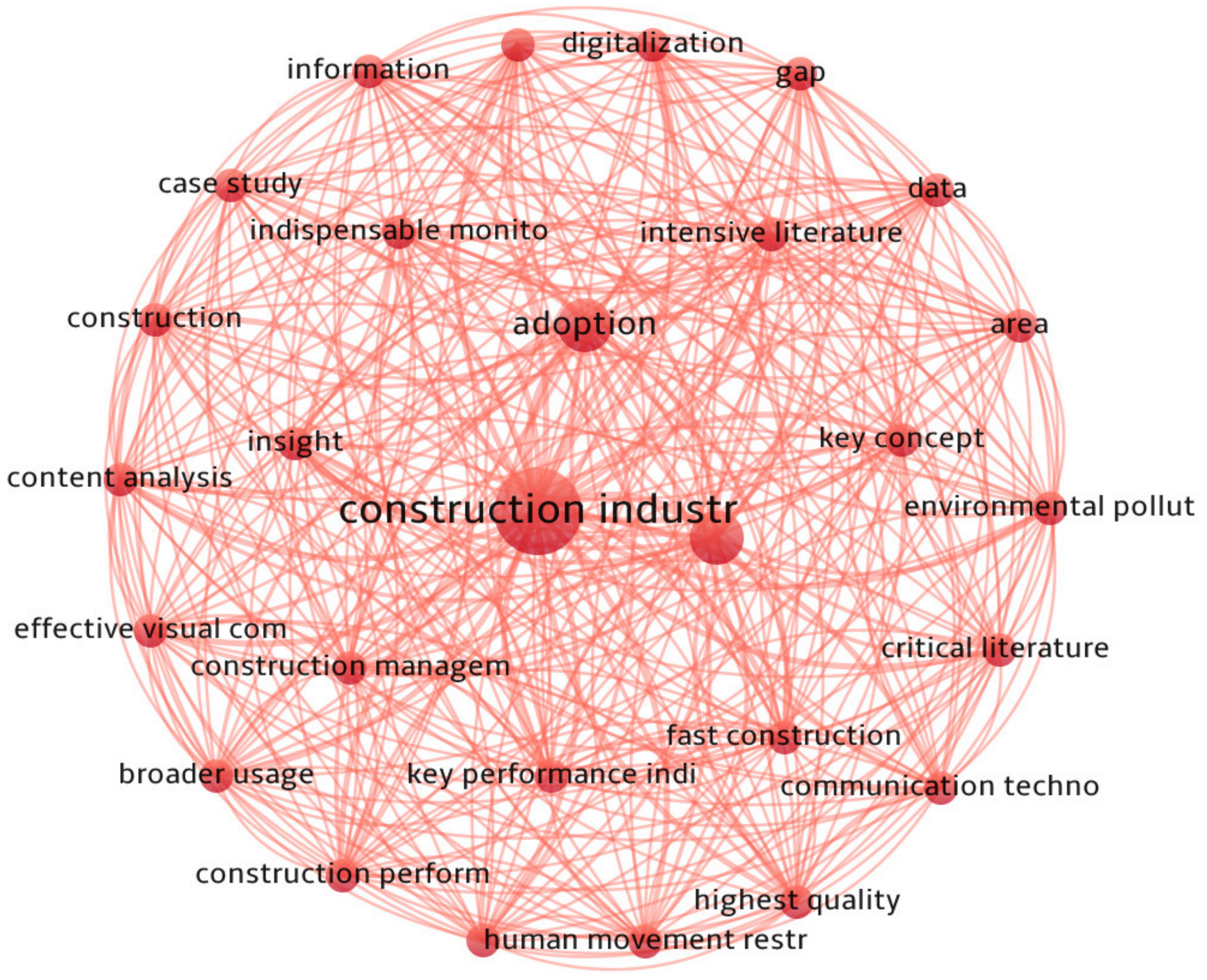
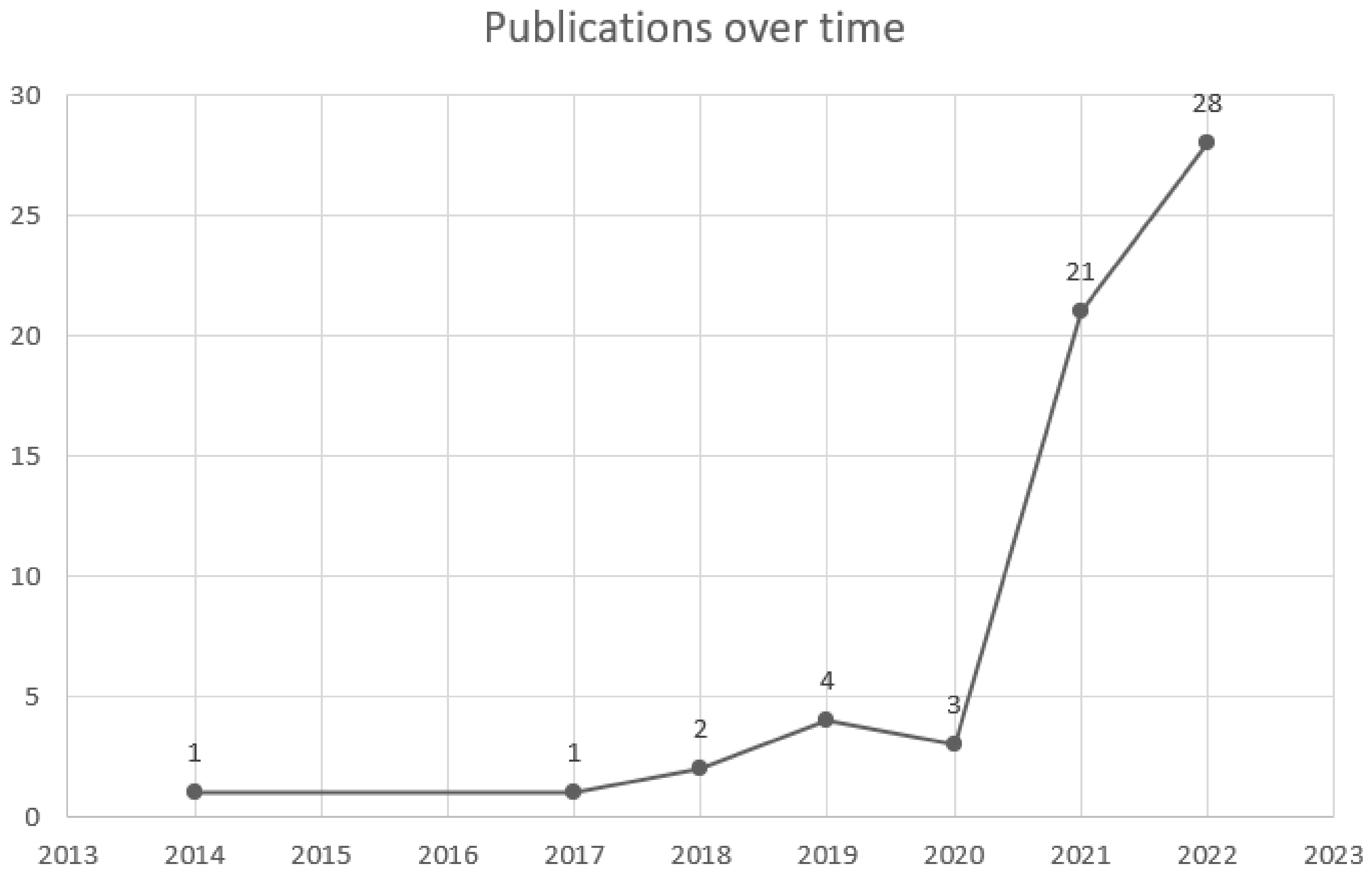
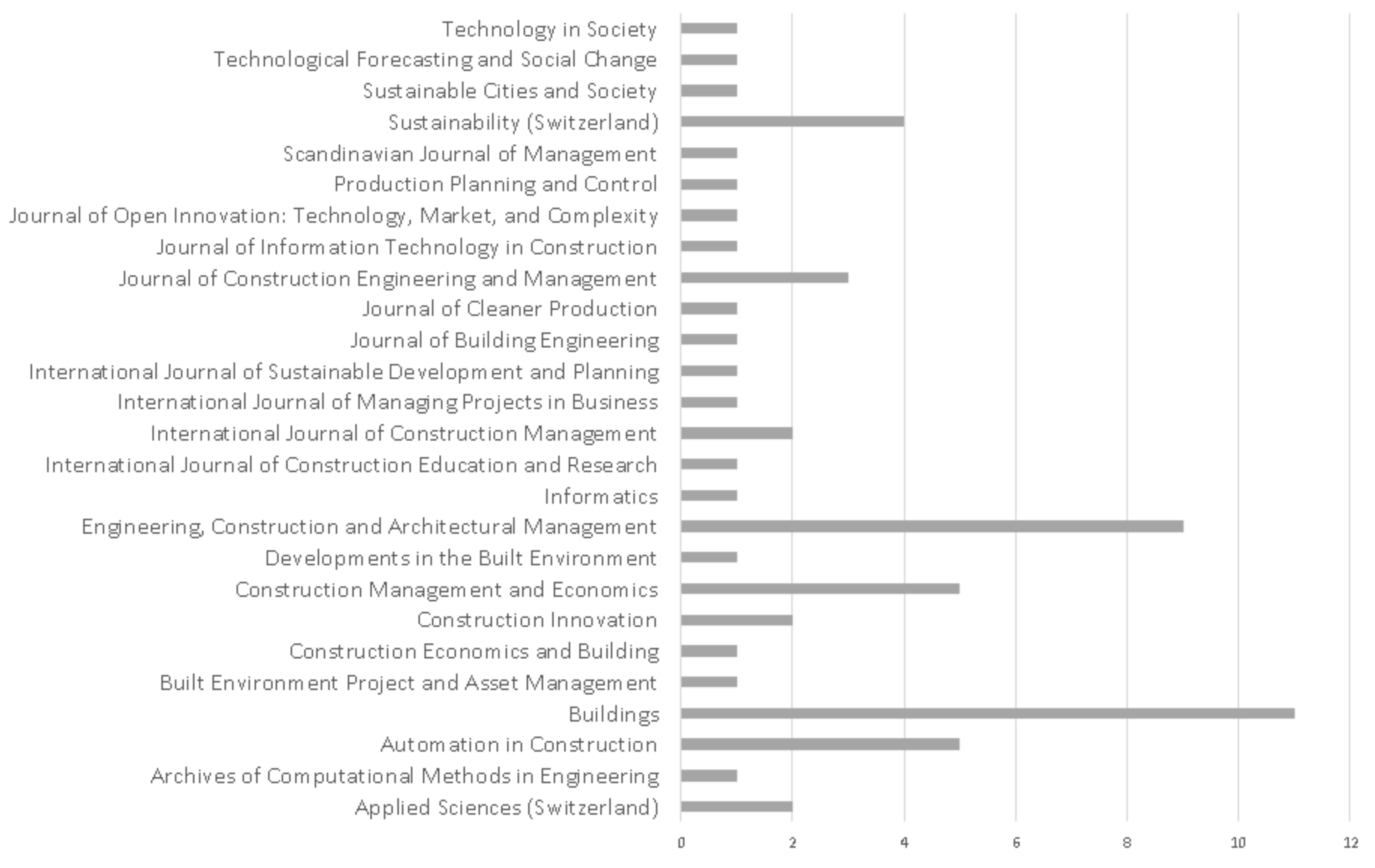
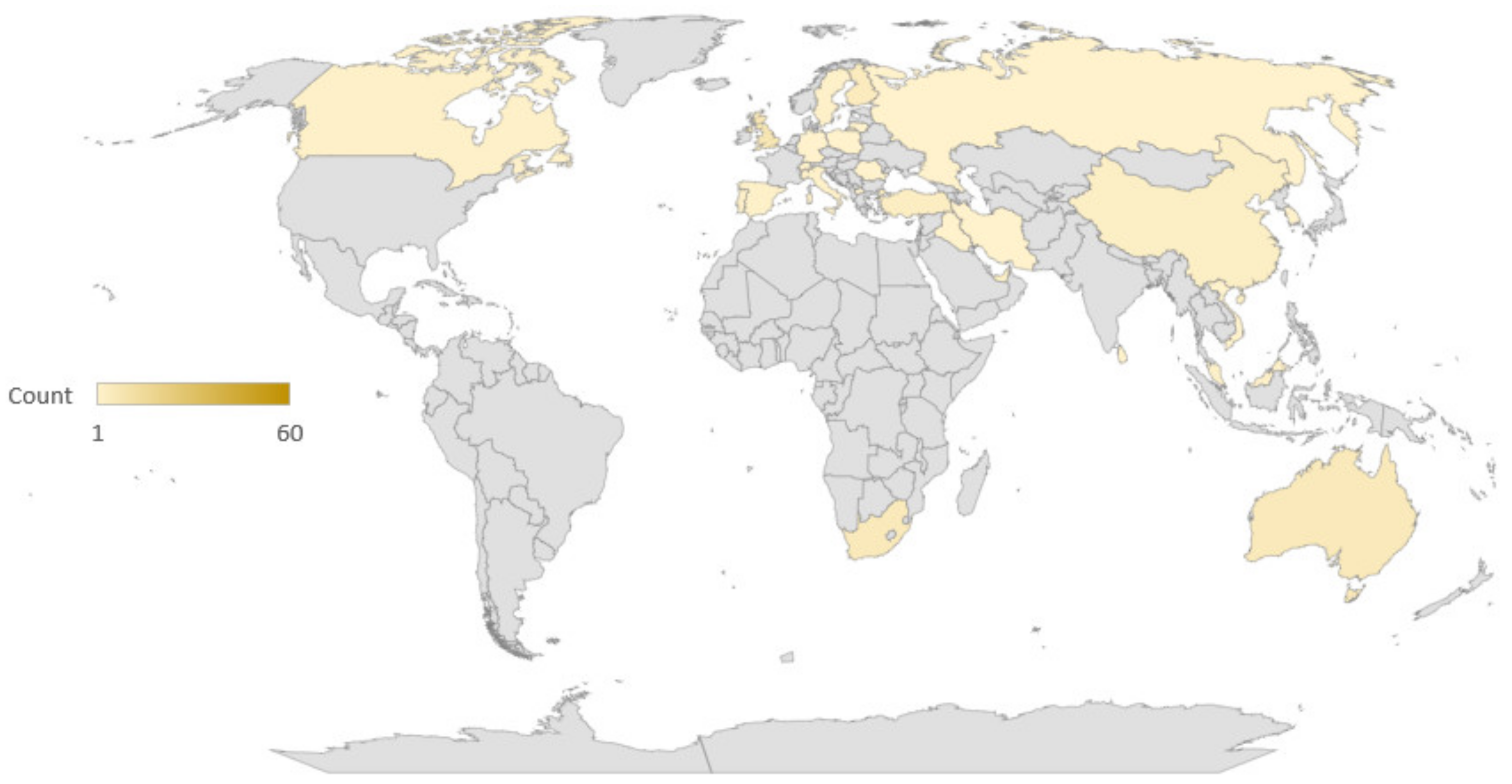
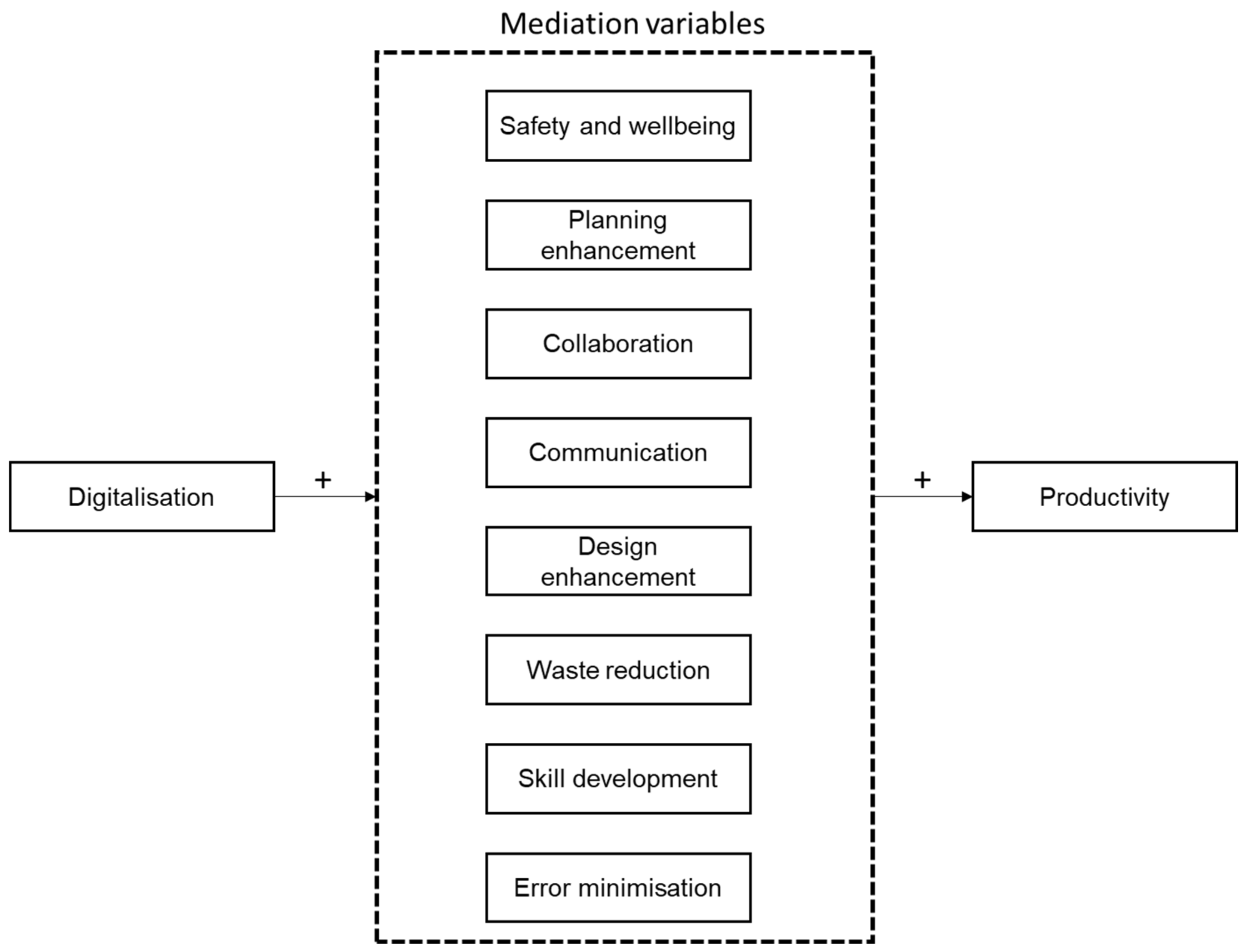
Disclaimer/Publisher’s Note: The statements, opinions and data contained in all publications are solely those of the individual author(s) and contributor(s) and not of MDPI and/or the editor(s). MDPI and/or the editor(s) disclaim responsibility for any injury to people or property resulting from any ideas, methods, instructions or products referred to in the content. |
© 2023 by the authors. Licensee MDPI, Basel, Switzerland. This article is an open access article distributed under the terms and conditions of the Creative Commons Attribution (CC BY) license (https://creativecommons.org/licenses/by/4.0/).
Share and Cite
Zulu, S.L.; Saad, A.M.; Omotayo, T. The Mediators of the Relationship between Digitalisation and Construction Productivity: A Systematic Literature Review. Buildings 2023, 13, 839. https://doi.org/10.3390/buildings13040839
Zulu SL, Saad AM, Omotayo T. The Mediators of the Relationship between Digitalisation and Construction Productivity: A Systematic Literature Review. Buildings. 2023; 13(4):839. https://doi.org/10.3390/buildings13040839
Chicago/Turabian StyleZulu, Sambo Lyson, Ali M. Saad, and Temitope Omotayo. 2023. "The Mediators of the Relationship between Digitalisation and Construction Productivity: A Systematic Literature Review" Buildings 13, no. 4: 839. https://doi.org/10.3390/buildings13040839
APA StyleZulu, S. L., Saad, A. M., & Omotayo, T. (2023). The Mediators of the Relationship between Digitalisation and Construction Productivity: A Systematic Literature Review. Buildings, 13(4), 839. https://doi.org/10.3390/buildings13040839








